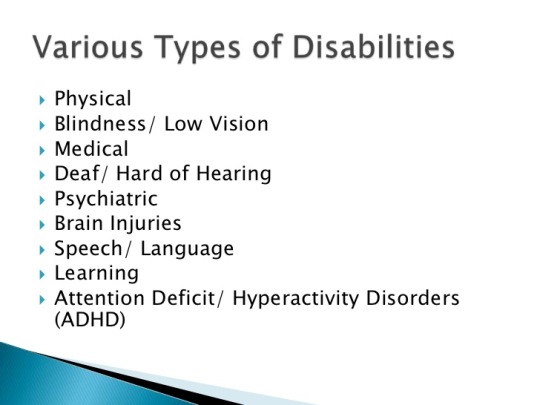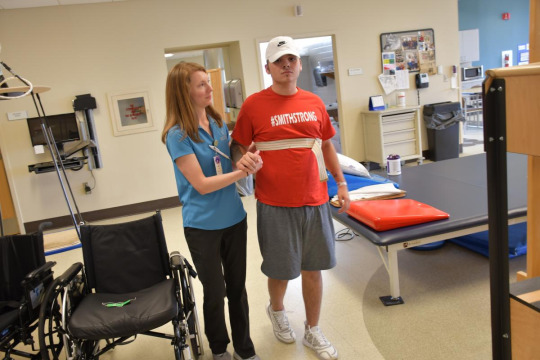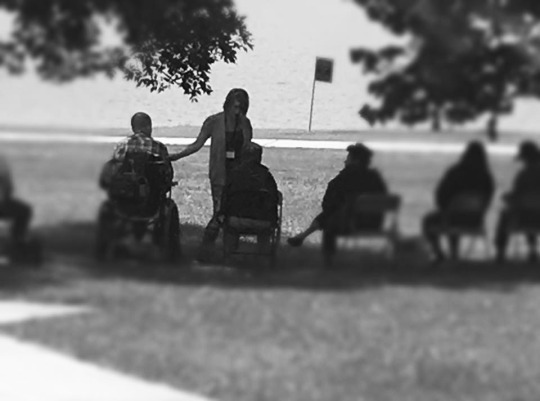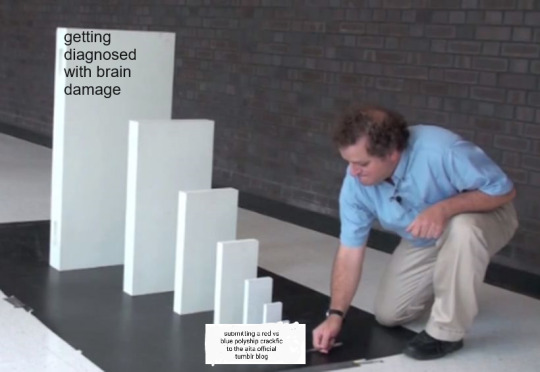#Brain Injuries
Text
Reminder from someone with actual literal brain damage from a brain injury to stop fucking using "brain damage" and "brain injuries" as a means of describing someone whose opinions you don't like or deem as stupid.
It's ableist and offensive as fuck, and for some reason a lot of leftist people think it's okay to use. I've seen posts replying to right wing racists calling them "brain damaged if you believe this" and "do you have a brain injury? do you not understand X?". Just now I saw a beautiful post about fat people throughout history that was absolutely ruined by opening with "How do we break it to boomers with actual brain damage and nostalgic brainrot..." before continuing to say that fat people existed throughout history.
Brain damage does not make you racist. A brain injury doesn't make you stupid, or fatphobic, or unaware of history and politics. Stop fucking using my disability as a catch all to describe people you think are shitty. Y'all use it like it's a replacement for how people used to use the R-slur, which shows you learned absolutely nothing about why the R-slur was wrong to use and decided to throw in other disabilities instead. Fuck off and stop doing it.
(And don't do it with other disabilities either, because I know y'all do.)
I know a lot of people with brain injuries. They're smart, and funny, and compassionate. They learn about the world and care about social issues and wish they could go to protests if their disability won't allow them to. Are there right wing people with brain injuries? Sure, absolutely. But they are not right wing because they have a brain injury, and using any disability as an insult is still fucking ableist.
Tldr - stop using brain damage and brain injury as an insult. It's ableist and incredibly offensive.
Love, your local brain injured/brain damaged pal
#brain injuries#ableism#disability#makes me so fucking angry#brain injury#brain damage#tbi#concussion
10K notes
·
View notes
Text
It almost seems like non-disabled people have a harder time accepting when a chronically disabled person will never get better - and maybe even deteriorate over time, than the affected person has.
"Aww don't lose hope"
There is no hope to be had? Stop pushing your toxic positivity down my throat when I have come to terms with my situation and am grieving already.
Losing hope is what has given me an ounce of peace of mind. This is what life is now. It's not your grief, it's mine.
#chronic illness#spoonie#my grief#chronic fatigue#disability awareness#disabled#cripple#cripple punk#disability#tbiawareness#chronically disabled#chronically ill#brain injuries#nebulow#hope
9K notes
·
View notes
Text

#big vibes#headache#chronic pain#spoonie#brain injuries#migraine#brain injury#pain#pain flare#vibes#cluster headaches#smile
53 notes
·
View notes
Text


gofund.me/a860b9d3
I’ve a crazy Jane Doe Story. A real-life Female version of Two Face, a Ms Harvey Dent of sorts.
Please read my story, donate to help my medical expenses and I’ll donate a portion to the epilepsy foundation.
Thank you.
#epilepsy#brain injuries#do good#giveback#akf#castiel#misha collins#jared paladecki#spn#spnfamiiy#zaddydent#gotham knights#medical bills#eeg#donatetoday#donate if you can#love
4 notes
·
View notes
Text
Alzheimer's Disease: biomarkers and neuroimaging markers cheatsheet for research articles
As Alzheimer's Disease (AD) research skews toward understanding the brain than the pathogenic proteins, studies exploring biomarkers and neuroimaging are hopeful toward developing a method for successful prevention of AD. A biomarker is a molecule, whose presence indicates abnormality or disease, and thus, is crucial in diagnostic procedures. Levels of certain molecules is notably altered in cerebrospinal fluid and in blood plasma, which helps in diagnosing the occurrence of AD. Neuroimaging involves the use of techniques such as magnetic resonance imaging and computed tomography to observe neuronal activity in the brain. This is good news, especially for AD, as the asymptomatic stage of the disease can be identified early enough.
Although the exact function and involvement in clinical practice is not profuse, altered concentrations of these biomarkers in plasma or cerebrospinal fluid encourage further research:
Amyloid and tau serve as the unsurprising biomarkers of AD pathology.
Neurofilament-light chain (NF-L) and visinin-like protein-1 (VILIP-1) are the most promising biomarkers of neuronal injury.
Post-synaptic protein neurogranin (Ng) and pre-synaptic proteins synaptosome-associated protein-25 (SNAP-25) and synaptotagmin-1 (Syt-1) are considered major biomarkers of synaptic injury.
Brain and CSF levels of tumor necrosis factor alpha (TNF-α) and increased levels of interleukin group of proteins (ILs) indicate intensified microglial response to neuroinflammation.
TREM2 receptor and YKL-40 glycoprotein are also reliable indicators of inflammation and impaired clearance of amyloid beta.
Heart-type fatty acid-binding protein (hFABP) could be a marker for pathology in blood vessels supplying the brain. Some vascular markers also show potential as markers of vascular injury in AD: von Willebrand factor (vWF) and monokine induced by γ-interferon (MIG, also known as CXCL-9).
Concentrations of TAR-DNA binding protein (TDP-43) in the brain and plasma and serum indicate, even contribute to, inflammation, mitochondrial dysfunction, and neuronal/synaptic injury in AD.
Neuroimaging techniques reveal structural, functional, and diffusion-related activities of the neurons. To identify them, markers are tracked in images obtained. Each marker is determined with the activity and biochemistry of the group of/individual neurons being studied.
Structural MRI will show location and severity of atrophy which can be identified in grey scale images by applying programs that create analogous color grading.
Functional MRI relies on blood oxygenation level dependent (BOLD) signal which reflects changes in blood oxygenation levels in response to neural activity.
Diffusion weighted imaging (DWI) focuses on diffusion of water molecules. A tensor model is applied to images obtained from DWI. The diffusion tensor imaging (DTI) metrics thus obtained help in studying connectivity through structural integrity of white matter tracts.
Tractography involves 3-D reconstruction of white matter as observed in DWI, which provides a more detailed look into a patient’s neural networks.
In positron emission tomography (PET), markers are identified and labelled so their features or functions can be traced during this procedure to obtain a resulting PET scan. The imaging procedure is named according to its marker: amyloid-PET, tau-PET, FDG-PET, inflammation-PET, receptor-PET.
FDA approved drugs Galantamine, Rivastigmine, and Donepezil alleviate symptoms such as memory loss and confusion in mild to moderate AD, although their effects seem to be negligible. They also cause nausea and vomiting as side effects and are not suitable for every patient. Recently approved drugs, Aducanumab and Lecanemab focus on removing accumulated amyloid. Their effectiveness is still doubted on the basis of studies finding that targeting amyloid has little to do with curbing the actual progression of the disease.
bibliography -
Tarawneh R. Biomarkers: our path towards a cure for Alzheimer disease. Biomarker insights. 2020 Nov;15:1177271920976367.
Cavedo E, Lista S, Khachaturian Z, Aisen P, Amouyel P, Herholz K, Jack Jr CR, Sperling R, Cummings J, Blennow K, O’Bryant S. The road ahead to cure Alzheimer’s disease: development of biological markers and neuroimaging methods for prevention trials across all stages and target populations. The journal of prevention of Alzheimer's disease. 2014 Dec;1(3):181.
Medications for Alzheimer's Disease Stanford Healthcare. Accessed 21-04-2023.
#aging#alzheimers#dementia#neuroscience#clinical medicine#diagnostics#diagnosis#brain injuries#neurological conditions#neurodegenerative disorders#neurodegeneration#neurons#neurology#brain research#neurological disease#neurological disorders and injuries#chronic illness#neuroinflammation#neuroimaging#science#science side of tumblr#research paper#academic writing
6 notes
·
View notes
Text

I walked head first into a metal bird feeder and hit my head right where my tbi (traumatic brain injury) is from one of my previous concussions…
Y’all I’m a fuckin mess. Send help. I can’t see right out of my right eye it keeps unfocusing on me. Someone get me a fuckin helmet for Christmas.
#i laughed harder than i should have#selfie#me irl#im crying#I’ve honestly lost count on what concussion this is but I think I’ve finally hit double digits#this is the second this year though#last one wasn’t that bad in all honesty#this one is gonna be fuckin rough I can tell#I already made an appointment with my neurologist to talk to them about it#but seriously someone please start a get Colby a helmet fund#I need a damn helmet and a knee brace#I’m so busted#brain injuries#tbirecovery#concussion#i’m so fucking annoyed
5 notes
·
View notes
Text
Learn from the various type of Disabilities!

Education for people with disabilities, A guide for ensuring inclusion and equity in education.
#physical disability#Blindness#low vision#Deaf#psychiatric disorder#brain injuries#speech disorder#language disorder#learning disorder#attention deficit disorder (add)#attention deficit hyperactivity disorder#disabled persons
3 notes
·
View notes
Text
Curtis Cripe Shares Tips for Those Supporting Loved Ones with Brain Injuries
Curtis Cripe: Helpful Tips for Family and Caregivers of Individuals with Brain Injuries
Caring for a loved one with a brain injury involves various complexities, requiring patience, understanding, and resilience. It can be a journey filled with challenges but also moments of profound connection and growth. In this context, Curtis Cripe offers invaluable tips and insights tailored to family members and caregivers, providing guidance and support in navigating the unique demands of this role.

Learn more about brain injury.
Start by educating yourself about the specific type of brain injury your loved one has. Understanding the nature and consequences of brain injuries will enable you to provide better support during their recovery journey. This knowledge can help you anticipate challenges, offer appropriate assistance, and be a source of comfort for your loved ones as they navigate through this difficult time.
Empower them with independence.
Promote independence in brain injury patients whenever feasible. Empower them to make choices and engage in decision-making, even if it necessitates additional time and patience.
Encourage rehabilitation exercises.
Support their rehabilitation efforts by providing positive reinforcement and creating a supportive environment. Encourage them to actively engage in the exercises prescribed by their healthcare team, emphasizing the importance of consistency in their routine. Consistent effort is crucial for steady progress and achieving rehabilitation goals.
Be patient when dealing with emotional challenges.
Brain injuries can often result in emotional changes due to the impact on cognitive functions and neural pathways. It is crucial to approach individuals with patience and understanding as they navigate these challenges. If necessary, do not hesitate to seek the support of mental health professionals who specialize in traumatic brain injuries for comprehensive guidance and assistance.
Understand the impact of brain injury.
Some challenges individuals face may not be immediately evident to others. Invisible struggles such as cognitive difficulties, memory lapses, and persistent fatigue can significantly influence one's daily life and interactions. It's important to demonstrate empathy, understanding, and flexibility to effectively support those dealing with such invisible battles.
Address communication barriers.
Communicating with brain injury survivors can present unique challenges due to cognitive impairments that may affect language processing and expression. It is crucial to use clear and straightforward language to facilitate understanding. Additionally, being a patient and attentive listener is important, allowing them the necessary time to articulate their thoughts and feelings effectively.

Take notes.
Memory issues are a frequent occurrence for many individuals. It can be beneficial to keep vital information documented in order to mitigate the impact of forgetfulness. Utilizing tools such as calendars, reminders, and notes can significantly aid in maintaining an organized approach to daily tasks and responsibilities.
Track their progress.
Remember to celebrate the small victories along the way! It's important to acknowledge and appreciate progress, whether it's in physical improvements, reaching cognitive milestones, or enhancing emotional resilience. You can stay motivated and encouraged on your journey by keeping track of these achievements.
Curtis Cripe mentions that every brain injury is unique, meaning what helps one person may not be suitable for another. Stay adaptable, show compassion, and reach out to fellow caregivers and experts. Remember, you're not walking this road to recovery alone.
Learn more about NTL Group's research and development head Dr. Curtis Cripe and his work by clicking on this link.
0 notes
Text
Improved Neuromonitoring Could Prevent Brain Injuries for Patients on ECMO Life Support - Technology Org
New Post has been published on https://thedigitalinsider.com/improved-neuromonitoring-could-prevent-brain-injuries-for-patients-on-ecmo-life-support-technology-org/
Improved Neuromonitoring Could Prevent Brain Injuries for Patients on ECMO Life Support - Technology Org
Rochester researchers are developing multimodal, non-invasive ways to study the brain’s physiology and reduce neurological issues associated with the therapy.
BRAIN FLOW ILLUMINATED: Diffuse correlation spectroscopy (DCS) uses near-infrared light to non-invasively measure blood flow about one centimeter into brain tissue. Image credit: University of Rochester photo / J. Adam Fenster
Extracorporeal membrane oxygenation (ECMO) can be a life-saving therapy for patients with acute heart or lung failure. During ECMO therapy, a patient’s blood flows out of their veins through tubes and into a machine that does both the actions of the heart and lungs. The oxygenated blood is then returned to the body allowing the heart and lungs to rest.
While ECMO can stabilize a critically ill patient in an intensive care unit, the procedure carries significant risks, including brain injury. Often these patients are comatose, and current neuromonitoring techniques are too risky and invasive to perform routinely. Now, researchers at the University of Rochester are devising new non-invasive, multimodal techniques to monitor the brain’s physiology and prevent harm.
Regine Choe, an associate professor of biomedical engineering and of electrical and computer engineering, and Imad Khan, an assistant professor of neurology and neurosurgery, have linked together multiple devices to evaluate different aspects of the brain’s health. The devices monitor the cortex, the brain’s outermost layer where neurons reside, using electroencephalography (EEG) to study electrical activity and a new optical method called diffuse correlation spectroscopy (DCS), which measures brain-blood flow. They also use evoked potentials—measurements of the electrical signals produced by the nervous system in response to an external stimulus— to examine deeper structures in the brain.
“Using near-infrared light, we can non-invasively evaluate blood flow about one centimeter into the brain tissue,” says Choe. “This is done by bouncing light off the red blood cells in the brain’s capillaries.”
She adds, “The correlation between blood flow measured by DCS and neural activity measured by EEG can tell us a lot about the health of the brain. We believe evoked potentials will provide important indicators about whether a patient can potentially wake up from their coma.”
ECMO therapy—enhanced with more data
The project began in 2019 with funding from a University Research Award and the team has tested it on more than 20 patients to date. Choe and Khan recently received a National Institutes of Health grant to further refine their method. The grant will allow them to test the process on 100 comatose patients who have suffered from cardiac arrest, some of whom are receiving ECMO and others who are not.
So far, the researchers have used DCS on the front portions of the brain, which has yielded intriguing findings such as asymmetric perfusion in the brain’s hemispheres. This finding may be caused by ECMO in patients who are comatose. The researchers want to expand perfusion monitoring to the 20 locations of the brain often used for EEG monitoring, thereby providing an additional metric for brain health. They aim to create a low-cost instrument incorporating both modalities that they can prepare for clinical trials.
The researchers say the data they collect through their system will provide important information to help clinicians optimize ECMO therapy.
MINDFUL INNOVATION: A prototype system links together multiple devices to evaluate different aspects of the brain’s health. The devices monitor the cortex, the brain’s outermost layer where neurons reside, using electroencephalography (EEG) to study electrical activity and a new optical method called diffuse correlation spectroscopy (DCS), which measures brain-blood flow. They also use evoked potentials—measurements of the electrical signals produced by the nervous system in response to an external stimulus—to examine deeper structures in the brain. Image credit: University of Rochester photo / J. Adam Fenster
“Our brains naturally have extremely intricate ways of controlling the amount of blood flow it receives, and how much oxygen and carbon dioxide need to be in the blood,” says Khan. “With ECMO, we are bypassing all of that to put blood flow and gas exchange in the hands of a clinician. Our device will provide clinicians with more data to make informed decisions about how to regulate these factors.”
Mark Marinescu, an assistant professor of clinical medicine and a cardiac intensivist collaborating on the project, believes the technique can help provide better care to patients and their families.
“A lot of times patients will come in unconscious because they are so sick and you have to make life-changing decisions about long-term medical devices to support them,” says Marinescu. “It would be really helpful to be able to predict if they are neurologically going to do okay afterwards. That would help us counsel patients’ families regarding what we should advocate for.”
Source: University of Rochester
You can offer your link to a page which is relevant to the topic of this post.
#Aging news#blood#Brain#brain injuries#brain injury#brains#carbon#Carbon dioxide#cardiac arrest#Cells#coma#computer#data#devices#engineering#extracorporeal membrane oxygenation (ECMO)#Featured life sciences news#Funding#gas#Health#heart#how#how to#injuries#Innovation#issues#it#life#Light#Link
0 notes
Text
seeing people my age talk about how scared they are of memory loss, which they only associate with old age, is so surreal to see as a 24 year old who has actively experienced memory loss for a long time now
there are causes for memory loss besides dementia and alzheimer’s, i hope y’all know that. dissociative disorders, trauma, brain injuries, thyroid problems, even just stress and lack of sleep can fuck up your ability to store, process, and access memory. and that’s just a few of the many causes i can think of off the top of my head right now.
please stop treating disabled people like some scary “other” that you might become only in the distant, decades-away future. we are your age, too. you may become one of us sooner than you know. stop acting like memory loss marks the end of a life, when so many of us have so much living left to do!
#diary#memory loss#memory disorder#dementia#alzheimers#dissociative disorder#dissociative amnesia#dissociation#dissociative identity disorder#trauma#brain injury#memory#amnesia#actually dissociative#complex dissociative disorder#osddid#osdd system#dissociative system#other specified dissociative disorder#did system
20K notes
·
View notes
Link
For years, researchers have studied the effects repeated blows to the head have on athletes in pro football, hockey, soccer and other sports. Now, researchers at Boston University are conducting the first major study of CTE, the degenerative brain disease linked to repeated hits to the head, in athletes who died before their 30th birthday. John Yang reports.
0 notes
Text
People without chronic pain will never understand that we can't 'just take some painkillers' and live our lives normally
#spoonie#chronic illness#chronic fatigue#disability awareness#disability#disabled#tbiawareness#chronically ill#brain injuries#chronically disabled#cripple punk#cripple
2K notes
·
View notes
Text
That moment when your doctor straight up says, "I don't know what to do here anymore. But you know what, if the neurologist doesn't want to book you in if you call (will take 2 years apparently to get an appointment), I'll just call her myself on Monday and tell her I need her consultation right now for an emergency and then she will have to." "In the meantime the best I can think of is to try these pain meds while you slow down the other preventative meds. I really have no other ideas"
Yeah, it's going great 👌
#priv#chronic headaches#chronic migraine#chronic pain#chronic headache#migraine#cluster headaches#headaches#head injury#headache#cluster headache#pain flare#pain#brain fog#brain injuries#brain injury
2 notes
·
View notes
Text
My Truth About Being a Yoga Teacher
I used to think that being a full time Yoga teacher would be the ultimate dream career. In many ways it has been, but the things I thought would be amazing turned out to be less important and there are a few things that have been really challenging and that has made the career a pretty tough one. Believe me it is not all comfy clothes and peaceful vibes.
Here are a few things I have learned in…

View On WordPress
#Adaptive Yoga#awareness#brain injuries#choices#colorado#healthy#healthy living#Love#meditation#Mindfulness#satya#spirituality#truth#wellness#Yoga#yoga teacher
0 notes
Text

#lmao#for anyone who's curious the process went:#send ask to aita official#blog blows up#someone realizes its a chexer fic#i follow them bc they seem cool#i join their rvb server#their encouragement pushes me to finish the Actual Fic i was working on#i expand the fic to be more of a whole au after it comes out much better than expected#the next fic in the au that i work on has to do with a character's brain injury#this leads me to do research into brain injuries#''......huh. this sounds. a lot like the neurological symptoms that my doctors have been saying is just part of my anxiety disorder''#think on that for a while#go to the ER for unrelated reasons#remember my theory#bring it up to the doctor#Doctor Immediate Concern#doctors orders a ct scan#''eeyup! that there's some atrophying and a chiari malformation! y'ever had a head injury''#(i had had several)#''well! shit! time to refer you to neurosurgery :) see if we cant do somethin about all that memory loss and severe pain and shit''#and now we are here#it also lead me to research osddid systems for the first fic#and now my therapist is having me tested for osdd because i did not know that those symptoms were not a thing everyone experiences#so like. thanks for helping me meet friends who could encourage me to engage with the things i like + learn more about myself#^ ^ <3#im actually not gonna say ''ok last update fr this time'' bc idfk maybe something WOULD be funny to post on here
6K notes
·
View notes
Text
Construction Injuries and Traumatic Brain Injuries: Legal Considerations
The construction industry is among those with a high rate of accidents. When an individual gets injured while working in this industry, they can suffer mild to severe injuries. This severity determines how soon they will go back to work. The good news is that a person can get compensated for the damages incurred from construction injuries.
Here is an analysis of the legal considerations for…

View On WordPress
#accident#accidents#attorney#brain injuries#construction#construction injuries#injuries#injury#injury lawyer#lawsuit#lawyer#lawyers#personal injury#traumatic brain injuries
0 notes